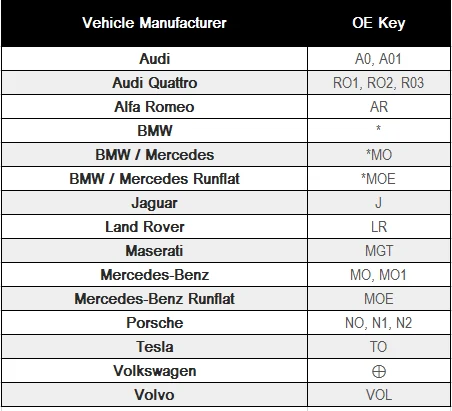
Understanding Tyre Homologation And OE Tyres
Depending on which new car you buy, you could find Continental, Dunlop or Good Year tyres fitted to the vehicle. Of course, there are many other quality brands that are also OE tyres (Original Equipment) but for now, let’s look a closer look at tyre homologation and what it means for you.
What Is Tyre Homologation?
Put plainly, tyre homologation works in collaboration with the Original Equipment Manufacturers (OEM) vehicle development process. This means that tyres that are specifically developed with, and approved by, a certain vehicle manufacturer, are “homologated”.
Tyre homologation involves fitting the right tyres to your car and understanding all the tyre labels form an important part. Many drivers don’t know how to read the labels on the tyre sidewall and it’s no surprise as it can be rather confusing.
Some may know how to identify tyre size, such as “215/60 R 15” but simply ignore the rest. This is a mistake especially if you drive a high-end vehicle like Audi, BMW, Jaguar, Mercedes-Benz, Mini, Land Rover, Tesla, Maserati or Porsche.
If a tyre is homologated, you can identify the vehicle manufacturer through a shortcode on the tyre sidewall. Below is a table of tyre homologation codes:

What Does The Tyre Homologation Process Involve?
The tyre homologation process is immensely painstaking as it often takes up to three years to complete. Typically, the process works as follows:
- A tyre manufacturer, such as Continental, will design, test and produce a new tyre
- During the test, leading vehicle manufacturers will determine the performance of the custom-made tyre when fitted to their vehicles
- To identify whether or not the generic tyre model can bring out the best in the vehicle, they test performance, grip, handling and weight
- After the comprehensive testing process, the car manufacturers provide feedback to the tyre manufacturer along with any suggested modifications to maximise performance
- At this point, the homologated version of the tyre is approved by the vehicle manufacturer
- Production of the tyre begins and is rolled out to the public bearing the relevant homologation code (or OE Key)
Are Homologated Tyres Safer Than Generic Premium Tyres?
The short answer is yes, but don’t take anything away from generic, non-homologated tyres such as the ones from Continental, for example. While they may not match the homologated tyres, these still go through rigorous research, development and testing. While they are engineered to perform the best possible handling, grip and braking, they don’t come close to homologated tyres.
In fact, the tyre homologation process ensures that the tyres are built to specifically enhance the characteristics unique to the type of vehicle. This involves meeting the exact criteria as set out by the vehicle manufacturer which simply results in better safety and performance characteristics.
The differences are usually subtle – such as a different tread pattern or rubber compound which can lead to better overall performance.
Recommended: ‘Driving Habits That Can Damage Your Car’
Tyre Labeling Guide
The EU passed new legislation in 2012 stating that every new tyre sold within Europe must be labelled. It’s unlikely that Brexit will affect the EU tyre label in the UK as it encourages tyre manufacturers to actively work to lower emissions which are a global concern. If it were to be discarded in the UK, we could possibly see a tyre labelling process similar to Japan or South Korea.
Either way, knowing your tyre size is important especially when buying new tyres. As mentioned earlier, many motorists don’t know their tyre size or what any of the other labels mean but Elite Garages can help. Looking at a tyre with the numbers, 215/60 R 16 91 H, what exactly do they mean?

Tyre Label Breakdown
- 215 indicates the tyre width measured in millimetres from sidewall to sidewall.
- 60 is the aspect ratio or the percentage of the tyre’s sidewall height compared to the tyre width. This figure indicates that the height of the tyre is 60% of its width.
- R is the construction code indicating that this particular tyre is manufactured with a radial ply construction. Majority of modern tyres are designed this way.
- 16 is the rim diameter measured in inches from one side of the wheel flange to the other.
- 91 shows the load index or maximum carrying capacity of your tyre measured in kg. In this example, cars with a load index of 91 have a maximum load capacity of 615 kg.
- The H in this tyre labelling example is the speed rating when tyre pressure is correct and when used under load. A tyre with a speed rating of H has a maximum speed of 130 mph (210 km/h).
Recommended: ‘Why Choose Elite Garages For Your Premium Tyres?’
Premium Tyres And Vehicle Services At Elite Garages
Finding the right tyres and knowing what the information means is challenging but our tyre experts are here to help. Elite aims to make the process as stress-free as possible starting with stocking over 1 million tyres across the group.
What’s more, we offer same-day tyre fitment or next day if we don’t have the tyre you need in stock. This is made possible due to our warehouse making daily deliveries so you can reserve your tyres online knowing we have you covered.
If you are looking for a friendly, professional and experienced service centre, get in touch with Elite Garages. We are here to help with all your vehicles needs including MOTs, car services, tyres, wheel alignment and much more. Be part of the conversation by joining us on Facebook and become a valued member of our online community.
About Us
Opening Times
Saturday : 8:30–4:00
Sunday : closed
More Information
Contact UsCustomer Information Pack
Check MOT Due Date
Free MOT reminder
Careers


